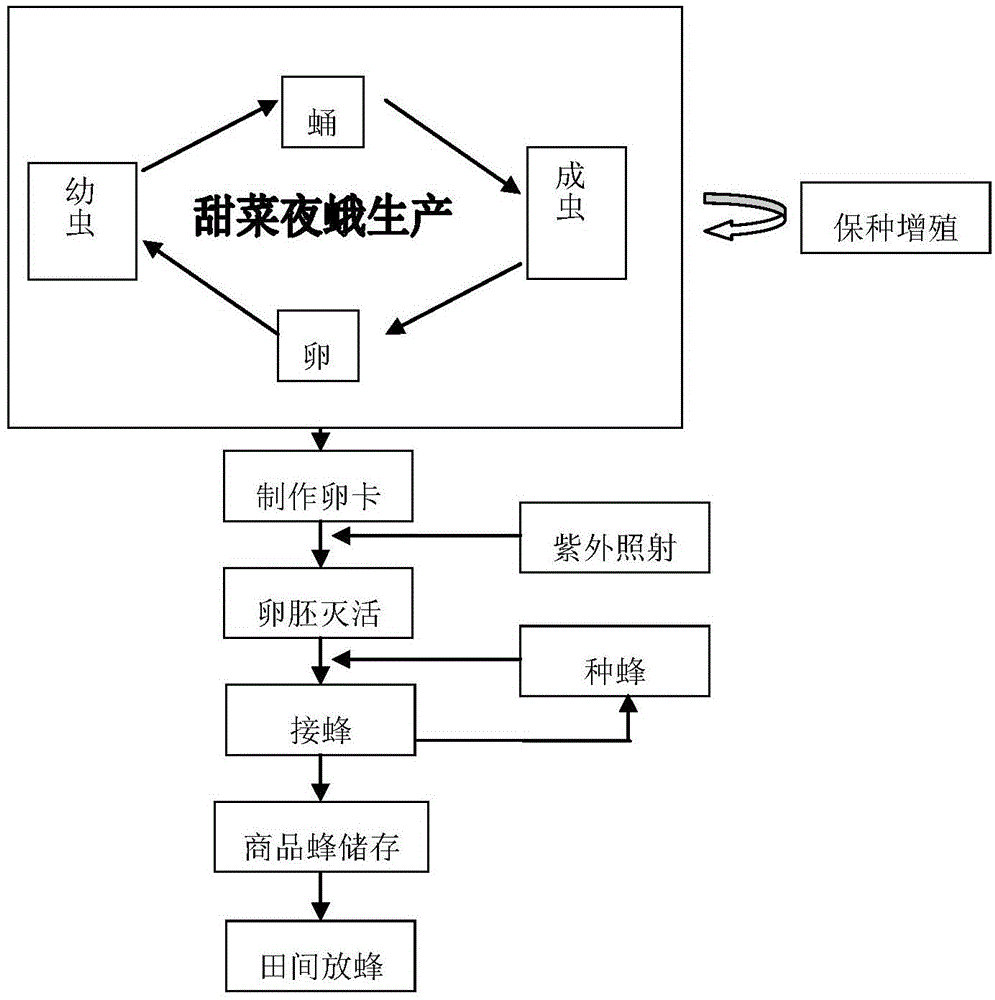Trichogramma japonicun ashmead artifical breeding production method
A technology for artificial breeding of Trichogramma, applied in animal husbandry and other directions, can solve the problems of difficulty in large-scale production, inability to complete development, difficulty in large-scale, commercialization, etc. High, short reproductive cycle effect
- Summary
- Abstract
- Description
- Claims
- Application Information
AI Technical Summary
Problems solved by technology
Method used
Image
Examples
Embodiment 1
[0049] Embodiment 1 produces beet armyworm egg
[0050] 1. For the rearing of beet armyworm, the temperature in the insectarium is controlled at 27±1°C and the humidity is about 65%.
[0051] The rearing of A larvae: Place the beet armyworm ovum that will hatch soon on one side of the petri dish, and add an appropriate amount of artificial feed on the other side, and cover with a lid with toilet paper to prevent the larvae from escaping. About 0.1 grams of eggs per dish. After 2 days of hatching, the larvae in one dish can be reared in 2 or 3 dishes separately; after another 2-3 days of growth, the larvae can be transferred to a large square box for feeding, and the larvae in 2-3 dishes can be combined into In a large square box, artificial feed is added; the number of larvae in each large square box can be adjusted according to the actual situation. Before pupation, there are about 400 larvae in each large square box, and the larvae of beet armyworm are about 12 days. Befo...
Embodiment 2
[0055] Embodiment 2 breeding Trichogramma rice borer
[0056] 1. The production of egg cards, the beet armyworm eggs used to receive bees are passed through a 40-mesh sieve, divided into single grains, and the eggs are poured on paper sheets coated with glue or glued with double-sided tape to make egg cards and dried in the air , (about 380 eggs of beet armyworm eggs per square centimeter), inactivated under 15 watts of ultraviolet light for 30 minutes.
[0057]2. The temperature of the breeding chamber is kept at 27±1°C, and the humidity is about 80%. Since the Trichogramma rice borer has phototaxis, the breeding chamber is generally dark when receiving bees. Put the prepared egg card into the bee-receiving box according to the bee-egg ratio of 1:10, and take it out after 1 day. Put in bee breeding and new egg cards every day. Place the egg cards that have been picked up at 27±1°C for 3 days until the Trichogramma rice borer develops to the pupae. Store in a refrigerator...
Embodiment 3
[0058] Embodiment 3 and the comparison of prior art and cost estimation
[0059] Trichogramma rice borer can parasitize the eggs of corn borer and armyworm, but the eggs of these two insects are in the form of lumps, which are not easy to remove from the egg-laying utensils to make egg cards, which limits the application; the life cycle of diamondback moth is short, and the reproduction Ligao can quickly expand the population in a short period of time and obtain a large number of eggs, but the eggs are small, resulting in a decline in the quality of the bred Trichogramma rice borer. Similarly, diamondback moth eggs are not easy to make egg cards and form standardization; Spodoptera litura The amount of eggs laid is large, and it is easy to make a standard egg card, but the Trichogramma rice borer cannot complete the development after being parasitized. Therefore, screening an alternative host with high production efficiency is an important basis for using Trichogramma as a b...
PUM
 Login to View More
Login to View More Abstract
Description
Claims
Application Information
 Login to View More
Login to View More - R&D
- Intellectual Property
- Life Sciences
- Materials
- Tech Scout
- Unparalleled Data Quality
- Higher Quality Content
- 60% Fewer Hallucinations
Browse by: Latest US Patents, China's latest patents, Technical Efficacy Thesaurus, Application Domain, Technology Topic, Popular Technical Reports.
© 2025 PatSnap. All rights reserved.Legal|Privacy policy|Modern Slavery Act Transparency Statement|Sitemap|About US| Contact US: help@patsnap.com

